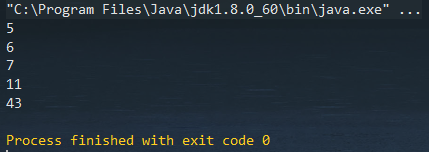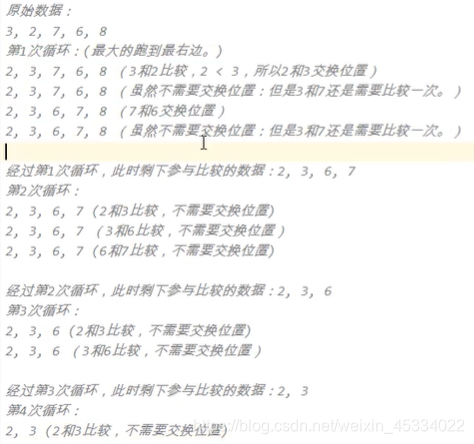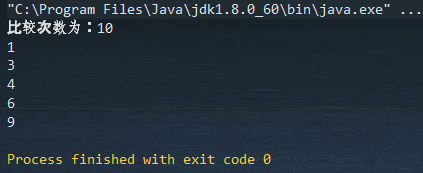- java.util.Arrays
1、Arrays是一个工具类。其中有一个sort()方法,可以排序。静态方法,直接使用类名调用就行。
2、代码示例:
import java.util.Arrays;
public class Demo{
public static void main(String[] args) {
int[] a = {6,7,11,43,5};
Arrays.sort(a);
for (int i = 0; i < a.length; i++) {
System.out.println(a[i]);
}
}
}
输出:

- 冒泡排序
1、图例:

2、简言之就是:
先把最大的往最右边挪,然后就可以忽略掉最右边的;再把第二大的往最右边挪,以此类推...每一次循环结束之后,都要找出最大的数据,放到最右边。
3、代码示例:
public class Demo{
public static void main(String[] args) {
int[] a = {9, 6, 4, 3, 1};
/*设置比较次数,
这里的比较次数也是交换次数*/
int count = 0;
for (int i = a.length-1; i > 0; i--) {
for (int j = 0; j < i; j++) {
if (a[j] > a[j+1]){
int temp;
temp = a[j+1];
a[j+1] = a[j];
a[j] = temp;
count++;
}
}
}
System.out.println("比较次数为:" + count);
for (int k = 0; k < a.length; k++) {
System.out.println(a[k]);
}
}
}
输出:

- 选择排序
1、选择排序:
每一次从这堆参与比较的数据当中找出最小值。拿着这个最小值和最前面的元素交换位置。选择排序比冒泡排序好在:每一次的交换位置都是有意义的。
2、所以选择排序比冒泡排序的效率高,高在交换位置的次数上。
3、代码示例:
public class Demo{
public static void main(String[] args) {
int[] a = {9,6,4,3,1};
int count=0;
int count2=0;
for (int i = 0; i < a.length-1; i++) {
int min = i;
for (int j = i+1; j < a.length; j++) {
count++;
if (a[min] > a[j]){
min = j;
}
}
if (min != i) {
int temp;
temp = a[min];
a[min] = a[i];
a[i] = temp;
count2++;
}
}
System.out.println("比较次数:" + count);
System.out.println("交换次数:" + count2);
for (int k = 0; k < a.length; k++) {
System.out.println(a[k]);
}
}
}
输出:

- 二分法查找
1、数组的元素查找数组元素查找有两种方式:
第一种方式:一个一个挨着找,直到找到为止。
第二种方式:二分法查找(算法),这个效率较高。
2、二分法查找算法是基于排序的基础之上。(没有排序的数据是无法查找的。)
3、二分法查找的终止条件:一直折半,直到中间的那个元素恰好是被查找的元素。
4、代码示例:
public class Demo{
public static void main(String[] args) {
int[] a = {1,3,4,7,12,34,45,56};
int index = binarySearch1(a,12);
System.out.println(index == -1? "该元素不存在" : "下标为" + index);
int index2 = binarySearch1(a,88);
System.out.println(index2 == -1? "该元素不存在" : "下标为" + index2);
}
private static int binarySearch1(int[] a, int dest) {
int begin = 0;
int end = a.length-1;
/* 开始元素的下标只要在结束元素下标的左边,
就有机会继续循环。*/
while (begin <= end){
int mid = (begin + end)/2;
if (a[mid] == dest){
return mid;
}else if (a[mid] < dest){
begin = mid + 1;//一直增
}else {
end = mid - 1;//一直减
}
}
return -1;
}
}
输出:

- java.util.Arrays之binarySearch方法
代码示例:
import java.util.Arrays;
import static java.util.Arrays.binarySearch;
public class DemoTest{
public static void main(String[] args) {
int[] a = {32,12,4,56,2,78,45,92,3};
//先排序
Arrays.sort(a);
//SUN公司写的二分法查找:binarySearch方法
int index = binarySearch(a,12);
/*返回值应为:-(a.length+1)。
因为源码中binarySearch方法返回值是:
return -(low + 1); // key not found.
*/
System.out.println(index == -(a.length+1)? "该元素不存在" : "下标为" + index);
int index1 = binarySearch(a,99);
System.out.println(index1 == -(a.length+1)? "该元素不存在" : "下标为" + index1);
}
}